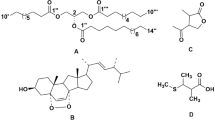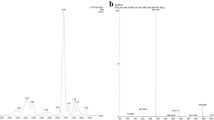Abstract
Muscodor spp. are proficient producers of bioactive volatile organic compounds (VOCs) with many potential applications. However, all members of this genus produce varying amounts and types of VOCs which suggests the involvement of epigenetics as a possible explanation. The members of this genus are poorly explored for the production of soluble compounds (extrolites). In this study, the polyketide synthase (PKS) and non-ribosomal peptide synthetase (NRPS) genes from an endophyte, Muscodor yucatanensis Ni30, were cloned and sequenced. The PKS genes belonged to reduced, partially reduced, non-reduced, and highly reduced subtypes. Strains over-expressing PKS genes were developed through the use of small-molecule epigenetic modifiers (suberoylanilide hydroxamic acid (SAHA) and 5-azacytidine). The putative epigenetic variants of this organism differed considerably from the wild type in morphological features and cultural characteristics as well as metabolites that were produced. Each variant produced a different set of VOCs distinct from the wild type, and several VOCs including methyl 3-(3,5-di-tert-butyl-4-hydroxyphenyl)hexane-2,4-diol and 2-carboxymethyl-3-n-hexylmaleic appeared in the variant strains, the production of which could be attributed to the activity of otherwise silent PKS genes. The bioactive extrolite brefeldin A was isolated and characterized from the wild type. However, this metabolite was not detected in EV-1, but instead, two other products were isolated and characterized as ergosterol and xylaguaianol C. Hence, M. yucatanensis has the genetic potential to produce several previously undetectable VOCs and organic solvent soluble products. It is also the case that small-molecule epigenetic modifiers can be used to produce stable variant strains of fungi with the potential to produce new molecules. Finally, this work hints to the prospect that the epigenetics of an endophytic microorganism can be influenced by any number of environmental and chemical factors associated with its host plant which may help to explain the enormous chemical diversity of secondary metabolic products found in Muscodor spp.





Similar content being viewed by others
References
Sun X, Guo L-D, Hyde KD (2011) Community composition of endophytic fungi in Acer truncatum and their role in decomposition. Fungal Divers. 47:85–95
Hoffmeister D, Keller NP (2007) Natural products of filamentous fungi: enzymes, genes, and their regulation. Nat. Prod. Rep. 24:393–416
Chiang YM, Lee KH, Sanchez JF, Keller NP, Wang CC (2009) Unlocking fungal cryptic natural products. Nat. Prod. Commun. 11:1505–1510
Scherlach K, Hertweck C (2009) Triggering cryptic natural product biosynthesis in microorganisms. Org Biomol Chem 7:1753–1760
Cichewicz RH (2010) Epigenome manipulation as a pathway to new natural product scaffolds and their congeners. Nat. Prod. Rep. 27:11–22
Brakhage AA, Schroeckh V (2011) Fungal secondary metabolites—strategies to activate silent gene clusters. Fungal Genet. Biol. 48:15–22
Sanchez JF, Chiang YM, Szewczyk E, Davidson AD, Ahuja M, Oakley CE, Bok JW, Keller NP, Oakley BR, Wang CC (2010) Molecular genetic analysis of the orsellinic acid/F9775 gene cluster of Aspergillus nidulans. Mol. BioSyst. 6:587–593
Heywood VH (1995) Global biodiversity assessment. Cambridge University Press, Cambridge
Hawksworth DL (2001) The magnitude of fungal diversity: the 1.5 million species estimate revisited. Mycol. Res. 105:1422–1432
Bode HB, Bethe B, Hofs R, Zeeck A (2002) Big effects from small changes: possible ways to explore nature’s chemical diversity. Chem Bio Chem 3:619–627
Bills GF, Platas G, Fillola A, Jimenez MR, Collado J, Vicente F, Martın J, Gonzalez A, Bur-Zimmermann J, Tormo JR, Pelaez F (2008) Enhancement of antibiotic and secondary metabolite detection from filamentous fungi by growth on nutritional arrays. J. Appl. Microbiol. 104:1644–1658
Chiang Y, Szewczyk E, Nayak T, Davidson AD, Sanchez JF, Lo H, Ho W, Simityan H, Kuo E, Praseuth A, Watanabe K, Oakley BR, Wang CCC (2008) Molecular genetic mining of the Aspergillus secondary metabolome: discovery of the emericellamide biosynthetic pathway. Chem Biol 15:527–532
Shwab EK, Bok JW, Tribus M, Galehr J, Graessle S, Keller NP (2007) Histone deacetylase activity regulates chemical diversity in Aspergillus. Eukaryot Cell 6:1656–1664
Bok JW, Chiang Y-M, Szewczyk E, Reyes-Domingez Y, Davidson AD, Sanchez JF, Lo H-C, Watanabe K, Strauss J, Oakley BR, Wang CC, Keller NP (2009) Chromatin-level regulation of biosynthetic gene clusters. Nat. Chem. Biol. 5:462–464
Birch PRJ, Sims PFG, Broda PJ (1998) A reporter system for analysis of regulatable promoter functions in the basidiomycete fungus Phanerochaete chrysosporium. Appl. Microbiol. 85:417–424
Riyaz-Ul-Hassan S, Strobel GA, Booth E, Knighton B, Floerchinger C, Sears J (2012) Modulation of volatile organic compound formation in the Mycodiesel producing endophyte Hypoxylon sp. C1-4. Microbiology 158:464–473
Asai T, Chung YM, Sakurai H, Ozeki T, Chang FR, Yamashita K, Oshima Y (2012) Tenuipyrone, a novel skeletal polyketide from the entomopathogenic fungus, Isaria tenuipes, cultivated in the presence of epigenetic modifiers. Org. Lett. 14:513–515
Wang Q, Yuan F, Pan Q, Li M, Wang G, Zhao J, Tang K (2010) Isolation and functional analysis of the Catharanthus roseus deacetylvindoline-4-O-acetyltransferase gene promoter. Plant Cell Report 29:185–192
Williams RB, Henrikson JC, Hoover AR, Lee AE, Cichewicz RH (2008) Epigenetic remodeling of the fungal secondary metabolome. Org. Biomol. Chem. 6:1895–1897
Ezra D, Hess WM, Strobel GA (2004) New endophytic isolates of Muscodor albus, a volatile-antibiotic-producing fungus. Microbiology 150:4023–4031
Riyaz-Ul-Hassan S, Strobel G, Geary B, Sears J (2013) An endophytic Nodulisporium sp. from Central America producing volatile organic compounds with both biological and fuel potential. J. Microbiol. Biotechnol. 23:29–35
Ausubel FM, Brent R, Kingston RE, Moore DD, Seidman JG, Smith JA, Struhl K (1994) Current protocols in molecular biology. Wiley, New York City
White TJ, Bruns T, Lee S, Taylor J (1990) Amplification and direct sequencing of fungal ribosomal RNA genes for phylogenetics. In: Innis MA, Gelfand DH, Sninsky JJ, White TJ (eds) PCR protocols: a guide to methods and applications. Academic, San Diego, pp. 315–322
Qadri M, Rajput R, Abdin MZ, Vishwakarma RA, Riyaz-Ul-Hassan S (2014) Diversity, molecular phylogeny and bioactive potential of fungal endophytes associated with the Himalayan blue pine (Pinus wallichiana). Microb. Ecol. 67(4):877–887
Altschul SF, Madden TL, Schaffer AA, Zhang JH, Zhang Z, Miller W, Lipman DJ (1997) Gapped BLAST and PSI-BLAST: a new generation of protein database search programs. Nucleic Acids Res. 25(17):3389–3402
Tamura K, Dudley J, Nei M, Kumar S (2007) MEGA4: Molecular Evolutionary Genetics Analysis (MEGA) software version 4.0. Mol. Biol. Evol. 24:1596–1599
González MC, Anaya AL, Glenn AE, Macías-Rubalcava ML, Hernández-Bautista BE, Hanlin RT (2009) Muscodor yucatanensis, a new endophytic ascomycete from Mexican chakah, Bursera simaruba. Mycotaxon 110:363–372
Amnuaykanjanasin A, Punya J, Paungmoung P, Rungrod A, Tachaleat A, Pongpattanakitshote S, Cheevadhanarak S, Tanticharoen M (2005) Diversity of type I polyketide synthase genes in the wood-decay fungus Xylaria sp. BCC 1067. FEMS Microbiol. Lett. 251:125–136
Bingle LE, Simpson TJ, Lazarus CM (1999) Ketosynthase domain probes identify two subclasses of fungal polyketide synthase genes. Fungal Genet. Biol. 26:209–223
Nicholson TP, Rudd BA, Dawson M, Lazarus CM, Simpson TJ, Cox RJ (2001) Design and utility of oligonucleotide gene probes for fungal polyketide synthases. Chem Biol 8:157–178
Paungmoung P, Punya J, Pongpattanakitshote S, Jeamton W, Vichisoonthonkul T, Bhumiratana S, Tanticharoen M, Linne U, Marahiel MA, Cheevadhanarak S (2007) Detection of nonribosomal peptide synthetase genes in Xylaria sp. BCC1067 and cloning of XyNRPSA. FEMS Microbiol. Lett. 274:260–268
Burge C, Karlin S (1997) Prediction of complete gene structures in human genomic DNA. J Mol Bio 268:78–94
Larkin MA, Blackshields G, Brown NP, Chenna R, McGettigan PA, McWilliam H, Valentin F, Wallace IM, Wilm A, Lopez R, Thompson JD, Gibson TJ, Higgins DG (2007) Clustal W and Clustal X version 2.0. Bioinformatics 23:2947–2948
Geourjon C, Deleage G (1995) SOPMA: significant improvements in protein secondary structure prediction by consensus prediction from multiple alignments. Comput. Appl. Biosci. 11:681–684
Kelley LA, Mezulis S, Yates CM, Wass MN, Sternberg MJE (2015) The Phyre2 web portal for protein modeling, prediction and analysis. Nat. Protoc. 10:845–858
Arnold K, Bordoli L, Kopp J, Schwede T (2006) The SWISS-MODEL Workspace: a web-based environment for protein structure homology modelling. Bioinformatics 22:195–201
Livak KJ, Schmittgen TD (2001) Analysis of relative gene expression data using real-time quantitative PCR and the 2-∆∆CT method. Methods 25:402–408
Qadri M, Deshidi R, Shah BA, Bindu K, Vishwakarma RA, Riyaz-Ul-Hassan S (2015) An endophyte of Picrorhiza kurroa Royle ex. Benth, producing menthol, phenylethyl alcohol and 3-hydroxypropionic acid, and other volatile organic compounds. World J. Microbiol. Biotechnol. 31:1647–1654
Kroken S, Glass NL, Taylor JW, Yoder OC, Turgeon BG (2003) Phylogenomic analysis of type I polyketide synthase genes in pathogenic and saprobic ascomycetes. Proc. Natl. Acad. Sci. U. S. A. 100:15670–15675
Glaser R, Shiftan D, Froimowitz M (2000) NMR structure determination of brefeldin-A, a 13-membered ring fungal metabolite. Magn. Reson. Chem. 38:274–280
Tao R, Wang CZ, Kong ZW (2013) Antibacterial/antifungal activity and synergistic interactions between polyprenols and other lipids isolated from Ginkgo biloba L. leaves. Molecules 18:2166–2182
Wu SH, He J, Li XN, Huang R, Song F, Chen YW, Miao CP (2014) Guaiane sesquiterpenes and isopimarane diterpenes from an endophytic fungus Xylaria sp. Phytochemistry 105:197–204
Newman DJ, Cragg GM (2012) Natural products as sources of new drugs over the 30 years from 1981 to 2010. J. Nat. Prod. 75:311–335
Strobel GA, Dirkse E, Sears J, Markworth C (2001) Volatile antimicrobials from Muscodor albus, a novel endophytic fungus. Microbiology 147:2943–2950
Harri E, Loeffler W, Sigg HP, Staehelin S, Tamm C (1963) Uber die isolierung der stoffwechselprodukte aus Penicellium brefeldianum Dodge. Helv Chim Acta 46:1235–1243
Wang F, Jiao R, Cheng A, Tan S, Song Y (2007) Antimicrobial potentials of endophytic fungi residing in Quercus variabilis and brefeldin A obtained from Cladosporium sp. World J. Microbiol. Biotechnol. 23:79–83
Betina V (1992) Biological effects of the antibiotic brefeldin A (decumbin, cyanein, ascotoxin, synergisidin): a retrospective. Folia Microbiol (Praha) 37:3–11
Misumi I, Misumi Y, Miki K, Takntsuki A, Tamura G, lkehara Y (1986) Novel blockade by brefeldin A of intracellular transport of secretory proteins in cultured rat hepatocytes. J. Biol. Chem. 261:11398–11403
Fisch KM, Gillaspy AF, Gipson M, Henrikson JC, Hoover AR, Jackson L, Najar FZ, Wagele H, Cichewicz RH (2009) Chemical induction of silent pathway transcription in Aspergillus niger. J. Ind. Microbiol. Biotechnol. 36:1199–1213
Atanasova L, Knox BP, Kubicek CP, Druzhinina IS, Baker SE (2013) The polyketide synthase gene pks4 of Trichoderma reesei provides pigmentation and stress resistance. Eukaryot Cell 12:1499–1508
Koch L, Lodin A, Herold I, Ilan M, Carmeli S, Yarden O (2014) Sensitivity of Neurospora crassa to a marine-derived Aspergillus tubingensis anhydride exhibiting antifungal activity that is mediated by the MAS1 protein. Mar Drugs 12:4713–4731
Spakowicz DJ, Strobel SA (2015) Biosynthesis of hydrocarbons and volatile organic compounds by fungi: bioengineering potential. Appl. Microbiol. Biotechnol. 99:4943–4951
Acknowledgements
This work was supported by the CSIR 12th FYP project (Grant Number PMSI-BSC0117) of the Council of Scientific and Industrial Research (CSIR), New Delhi, India, and the Major Lab Project MLP1008 of the institute. MQ is grateful to ICMR, India, for a Senior Research Fellowship. We are thankful to Miss Palak Arora for maintaining the growth of the cultures. We are also thankful to Mr. Chand Raina for running the fermentors and to Mrs. Kushal Bindu for recording the GC/MS. The article bears the institutional publication number IIIM/1955/2016.
Author information
Authors and Affiliations
Corresponding author
Electronic supplementary material
ESM 1
(DOCX 398 kb.)
Rights and permissions
About this article
Cite this article
Qadri, M., Nalli, Y., Jain, S.K. et al. An Insight into the Secondary Metabolism of Muscodor yucatanensis: Small-Molecule Epigenetic Modifiers Induce Expression of Secondary Metabolism-Related Genes and Production of New Metabolites in the Endophyte. Microb Ecol 73, 954–965 (2017). https://doi.org/10.1007/s00248-016-0901-y
Received:
Accepted:
Published:
Issue Date:
DOI: https://doi.org/10.1007/s00248-016-0901-y




